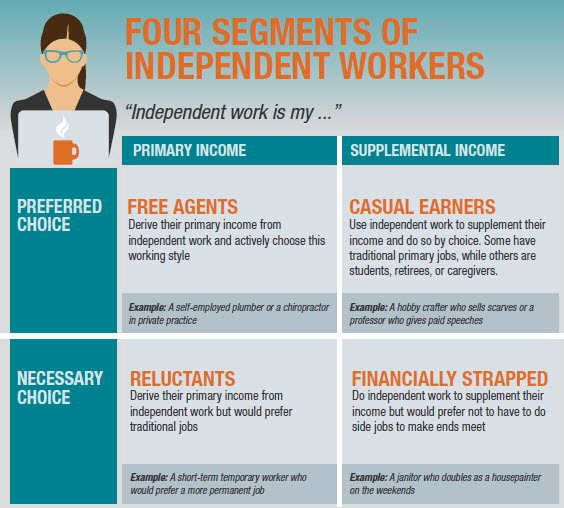McKinsey & Co published a very authoritative 148 page study (404 error as of 01/23) arguing a fairly simple (perhaps obvious) fact; the number of people freelancing is larger than you might think (20%+) and growing quickly. For those who already do project-based solo work this is non-news. We all know ex-consultants, Uber drivers, photographers, web-sign designers, caterers, eBay arbitragers, mortgage attorneys, and real estate agents who don’t have a “boss”. McKisney calls it the GIG economy and it’s larger than you think.
More than 20% of people are free-lancers
When measured by the 3 criteria of “a high degree of autonomy, payment by task, and short-term relationships between the worker and client”, McKinsey estimates that 20-30% of the working age population are free-lancers in the US and Europe which comes out to approximately 160+ million people. Not a trivial number.
Consultants LOVE 2×2 matrix
As you can see in the infographic below, McKinsey used two simple ways to think about this segmentation. 1) Is it primary or supplemental income? 2) Is it the preferred or non-preferred way of working. This creates a 2×2 (two by two) matrix which forms the basis of this reports segmentation. Simple, clever, good.

On a percentage basis, this breaks down into:
- 30% free agents who choose independent work; full-time; main source of income
- 40% casual earners who choose independent work to supplement income
- 14% reluctants who would actually prefer more traditional work arrangements
- 16% financially strapped who do this work because of necessity
Most people CHOOSE to work independently
More than 70% of people are doing independent work because they want to – not because they have to. This group is also happier than their traditional (40hr a week company bee) counterpart.
1 in 6 traditional workers would prefer to go independent
From my experience, I think this is true. A lot of company folks “SAY” they want to start their own business – but don’t have the capital, idea, ambition, network or grit. Ergo, they stay inside the walled garden of W2 income. Nothing to be ashamed of, but also nothing to be proud of.
Digital platforms enable freelance work
No surprise, technology makes it every easier and cheaper to connect demand and supply. Think of Uber, Ebay, and AirBnB. Transaction costs are cheaper than ever, yet, freelancers do not use technology evenly.
Of the 162M independent workers, it is only the ones selling goods, or leasing assets who aggressively use digital platforms. Instead, the majority of people are just providing their labor and contract it on their own, without a digital platform. Remember – there are a lot of solo consultants and single-shingle people out there.
This is not a new thing
Historically, independent work was more common. Looking back just 100 years, you can see that in the US, 45% of people were self-employed. It was only as the country became wealthier that company-based wage earning became the norm. This report argues that this trend has started to reverse. The next 100 years will see the % start to rise again.
Get to work – Yes, you.
One of the biggest impacts will be the ability to get retirees, +students, and caregivers back into the economy – even if partially. The US has 94M+ people who certainly have skills and capacity to contribute to the economy. The EU has 142M. These are all people who may / can use their skills and work capacity.
This 148pg report is 100 pages too long. This report could have been 120 pages shorter. This was a case where the writers spent too much time torturing the data to get too little out. There are dozen of pages which come to points with limited application and implication. A few examples of the obvious. My snarky comments in red.
- Seniors, caregivers, and students could be prime beneficiaries of flexible independent work opportunities and propel growth. And therefore. . .?
- Individual demand for labor services could grow. Uh huh. . .
- Independent work could potentially improve worker satisfaction and create opportunities for individuals to earn supplemental income. This is on page 89.
- Organizations need to think strategically about how to utilize independent providers. If one of my consultants had this as a title on one of his pages – ouch, I would put them in time-out. Not data-driven. Not new. Not specific, not actionable. Generally, boring and germane.
- Individuals need to manage their own work lives more actively than in the past. What? Please tell me that is not the last point made in this research paper? Yep.
Conclusion
Yes, consultants do rigorous work. No, it does not always produce new insights and recommendations. As consultants, we need to be comfortable creating deliverables which reflect the value of the findings. It is a pareto principle. Just because you did 148 pages worth of research and writing does not mean you should publish a 148pg report. Be parsimonious. Spare the client the long read. Get to the point. If you don’t have a point – don’t waste your time, and definitely not the clients.
Note: HUGE fan of McKinsey – just not this report. To those who might disagree – feel free to read the 148 pages here. See what I might have missed – but I warned you.
